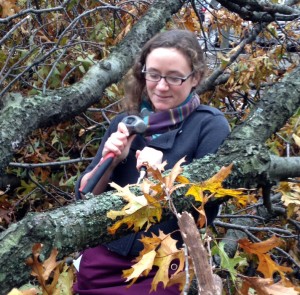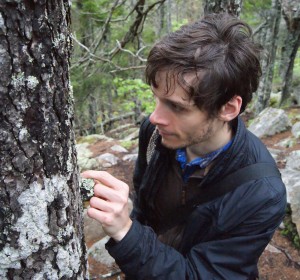Morning Eye Candy: For the Love of Lichen
Posted in Around the Garden, Photography on January 24 2013, by Matt Newman
Photo by Ivo M. Vermeulen

Inside The New York Botanical Garden
Posted in Around the Garden, Photography on January 24 2013, by Matt Newman
Photo by Ivo M. Vermeulen
Posted in Science on December 13 2012, by Jessi Allen
As a student studying lichens at the NYBG, Jessi Allen offers a unique perspective on these fascinating organisms–symbiotic combinations of fungus and algae. She first joined the NYBG as an Herbarium intern in the summer of 2011, and began her graduate studies this fall.

During Hurricane Sandy, many trees fell throughout the Garden. At least a few of those caused damage to buildings or left gaps in the landscape. However, the silver lining of this cloud came in the form of giving NYBG botanists a chance to collect data that we usually don’t have access to.
Of the trees that fell, one of them was a big oak near the Pfizer Lab that, luckily, landed in the parking lot. The day immediately following the storm, I was working in the lab and saw Mike Nee, one of our curators, climbing through the tangled branches taking cores from this tree, and I thought, “That looks like fun!” According to Mike, the tree was about 90 feet tall and close to 100 years old. Rarely are we able to collect lichens from the tops of such large trees, so I went and grabbed a hammer and chisel, common tools for collecting specimens.
Posted in From the Field, Science on September 27 2012, by Matt Newman
 You’ll find them clinging to rock faces like flecks of gray paint, or carpeting a tree trunk with skeins of red whisps. Lichens come in myriad shapes, sizes, colors, and consistencies. But while they’re often overlooked during your average hike, they’re worth giving a spare glance the next time you’re outdoors–lichens play an important part in the ecosystem. Few know this so well as the NYBG‘s Dr. James Lendemer. Like many of the Garden’s globetrotting scientists–Michael Balick, Bill Buck, and Roy Halling, to name a few–Lendemer’s field odysseys carry him well beyond the laboratory door in his hunt for specimens. In recent years, that chalks up to long days spent trekking through the Great Smoky Mountains of the eastern United States.
You’ll find them clinging to rock faces like flecks of gray paint, or carpeting a tree trunk with skeins of red whisps. Lichens come in myriad shapes, sizes, colors, and consistencies. But while they’re often overlooked during your average hike, they’re worth giving a spare glance the next time you’re outdoors–lichens play an important part in the ecosystem. Few know this so well as the NYBG‘s Dr. James Lendemer. Like many of the Garden’s globetrotting scientists–Michael Balick, Bill Buck, and Roy Halling, to name a few–Lendemer’s field odysseys carry him well beyond the laboratory door in his hunt for specimens. In recent years, that chalks up to long days spent trekking through the Great Smoky Mountains of the eastern United States.
For the uninitiated, lichens are cryptogams–fungi that reproduce by spores, as with other fungi and some groups of plants. But unlike either, lichens are unique in that they’re composite organisms, often a symbiotic combination of fungi and algae. Think of them as codependent roommates; the former acts as a sort of bodyguard for the latter in exchange for nourishing sugars from the algae’s photosynthesis. At large, lichens make the perfect bird nests by some avian standards, and the growths also have a penchant for breaking down dead trees and rocks while providing nitrogen for soil. Unassuming as they are, they’re integral to maintaining healthy biomes.